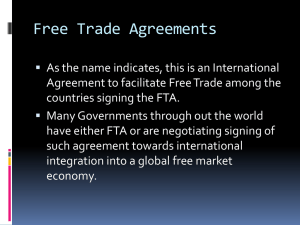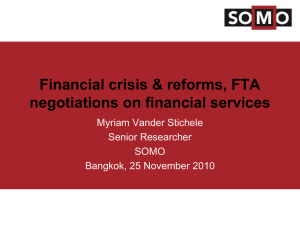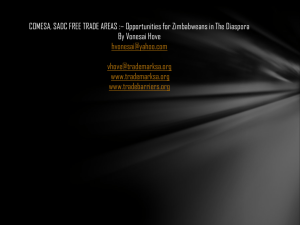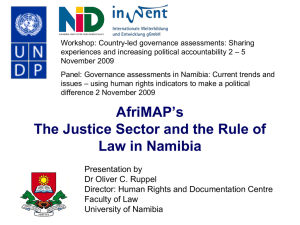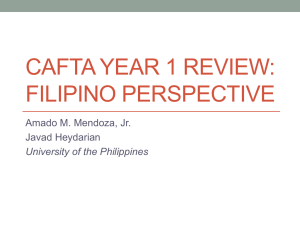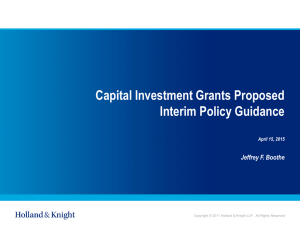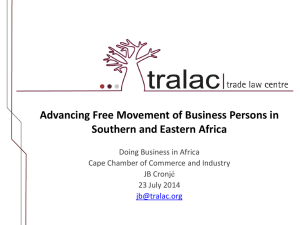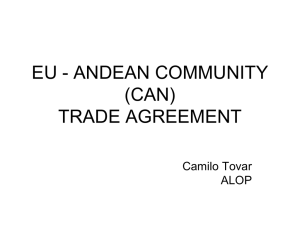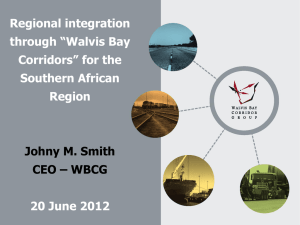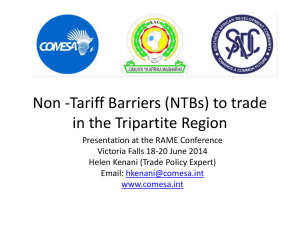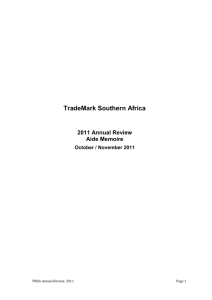view documents
advertisement
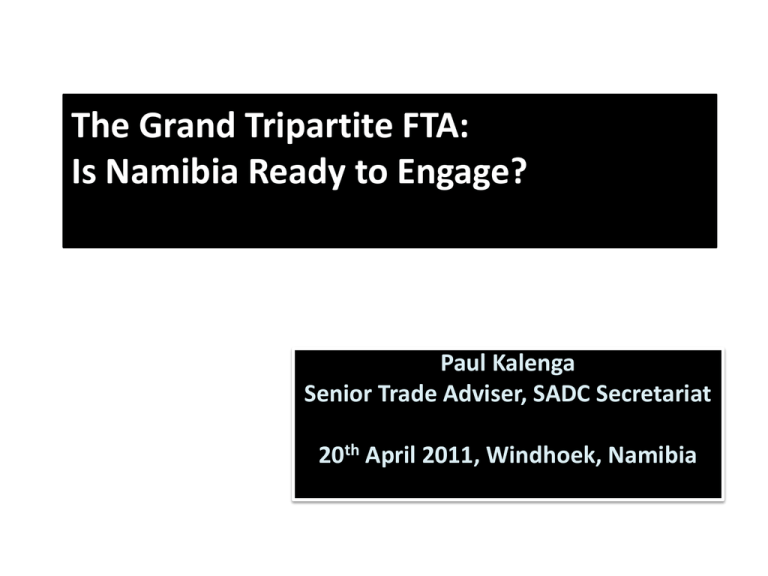
The Grand Tripartite FTA: Is Namibia Ready to Engage? Paul Kalenga Senior Trade Adviser, SADC Secretariat 20th April 2011, Windhoek, Namibia Introduction • Policy consensus that trade matters for growth and development • There is increasing policy consensus that regional trade openness (in the form of widening the economic spaces of fragmented small economies) matters for economic growth • Hence, the merging of national markets (through the establishment of FTAs ) as a growth and development strategy ( a rationale behind regional integration arrangements) • This partly explain why most countries in Eastern and Southern Africa have sought to belong to a number of trade regimes (see the famous spaghetti bowl-effect) • However, this has increasingly become a problem for implementation and for deepening regional integration (such as moving from FTAs to customs unions) Problem of overlapping memberships But intra-regional trade in Africa not yet a powerful engine for growth – why? • Production and export structures geared to primary commodities • Inadequate industrial capacity for diversified manufactured goods • Inadequate policy attention on trade in services as a catalyst for growth and investment • Inadequate infrastructure (transport & communications network, energy, IT, finance, skills, etc) • Persistent trade barriers (tariffs and non-tariff – design and implementation deficiencies of trade regimes) etc., etc., etc., • Caveat: intra-regional trade (SADC) is low in proportional terms – but it is still important for most SADC countries What is then the rationale for another wider FTA? • Addressing constraints posed by small fragmented domestic markets through export-growth strategies (this is not automatic but largely depends what a country does at the domestic level?) • Consolidating and improving existing trade regimes (SADC FTA, COMESA FTA, EAC FTA) • Addressing the high cost of trading / doing business (national actions and regional cooperation – infrastructure, trade & investment facilitation, NTBs, rules of origin, trade in services liberalisation, etc.) • Trade potential exists : intra-regional trade in manufactures (regional market integration could be a stepping stone to export manufactures)and there is a potential to raise it: available statistics ( 2007/8) – South Africa accounted for 10% of Botswana’s merchandise exports, 18% of Lesotho’s; 30% of Namibia’s and 75% of Swaziland’s.) • Zimbabwe, Mozambique, Zambia and Malawi each export between 10% and 34% of their total exports to South Africa (IMF Direction of Statistics) • Intra-regional trade in agriculture – why so low? The Tripartite framework – a brief background • SADC and COMESA interactions on the need to harmonize their programmes (especially in trade and customs since 2001) • In 2005, EAC became a Customs Union and joined what became known as the Tripartite Framework led by the Tripartite Task Force • First Tripartite Summit, Kampala, October 2008 decided to establish the Tripartite FTA • Technical work by the Secretariats on the design of the Tripartite FTA, since 2009 and now completed and to be used as a basis for negotiations • Second Tripartite Summit, scheduled for June / July 2011, South Africa, to launch the Tripartite FTA negotiations What can the grand tripartite FTA do? • Overcoming the problem of overlapping membership • Consolidating existing FTAs in COMESA, SADC and EAC into a single FTA by building on positive elements (acquis) and addressing their design and implementation shortcomings • Pursue sector-wide negotiations: avoid sensitive products and exclusions, include agricultural goods • Adopt simple and liberal rules of origin • Address non-tariff barriers (NTBs) and trade facilitation problems • A complementary strand on infrastructure, especially transport infrastructure (roads, rail, ports) and communication lin What are the potential economic effects • Trade creation? - specialization – has been a major source of trade growth in other regions such ASEAN - comparative advantage (manufactured clothing exports to RSA from Mauritius and Madagascar) Increased efficiency and productivity? • - • • Regional competition Regional economies of scale Foreign investment Trade diversion? (may be at the cost of trade with more efficient third countries) - External tariffs are reasonably high – must lower them to avoid trade diversion The cost of intra-regional transport, communication, doing business Is Namibia ready to engage? • Namibia’s sustained economic growth cannot depend on its small domestic market – there is no policy choice but to be export-oriented • For Namibia the FTA presents an opportunity( a market of 26 countries, with a combined GDP $264 billion and over 600 million people – more so if Angola and DRC can participate) • Namibia should have an offensive rather than a defensive strategy that goes beyond tariff liberalisation to addressing issues related to the high cost of doing business - trade infrastructure for trade facilitation, border measures • Namibia should strategically position itself as a transport hub within the Tripartite FTA (Walvisbay corridor, transport connection with Angola, DRC, Zambia, Zimbabwe, etc.) Is Namibia ready to engage? (cont.) • Developing a coherent national strategy on services sectors – outward looking rather than protectionist – services, growth and competitiveness of economies – a high potential for regional trade • Improving policy strategies to tackle constraints to manufacturing • An active engagement with the private sector (public-private partnership) for trade development and promotion – market analysis of opportunities and threats in the tripartite markets (both goods and services) • Governments do not trade – the FTA is for traders, investors, consumers • Build on success stories- exploit opportunities for which firms have a comparative advantage in regional markets / seek improved market access in goods and services markets Conclusions Trade policy choice for Namibia: • Domestic strategy for economic diversification (goods and services) to take advantage of the opportunities arising from the consolidation of the SADC FTA and the Tripartite FTA • Public/ private partnership to exploit opportunities (areas for which Namibia has a comparative advantage in neighboring markets (e.g. trade development and promotion activities, market research, etc.) • Positioning Namibia as a services hub, especially transport infrastructure / potential for making Walvisbay corridor a transport hub – leading to the cost of trading in the region • The need for a tripartite FTA regime to be a trade, transport and infrastructure facilitation rather a mere tariff liberalization strategy THANK YOU!

